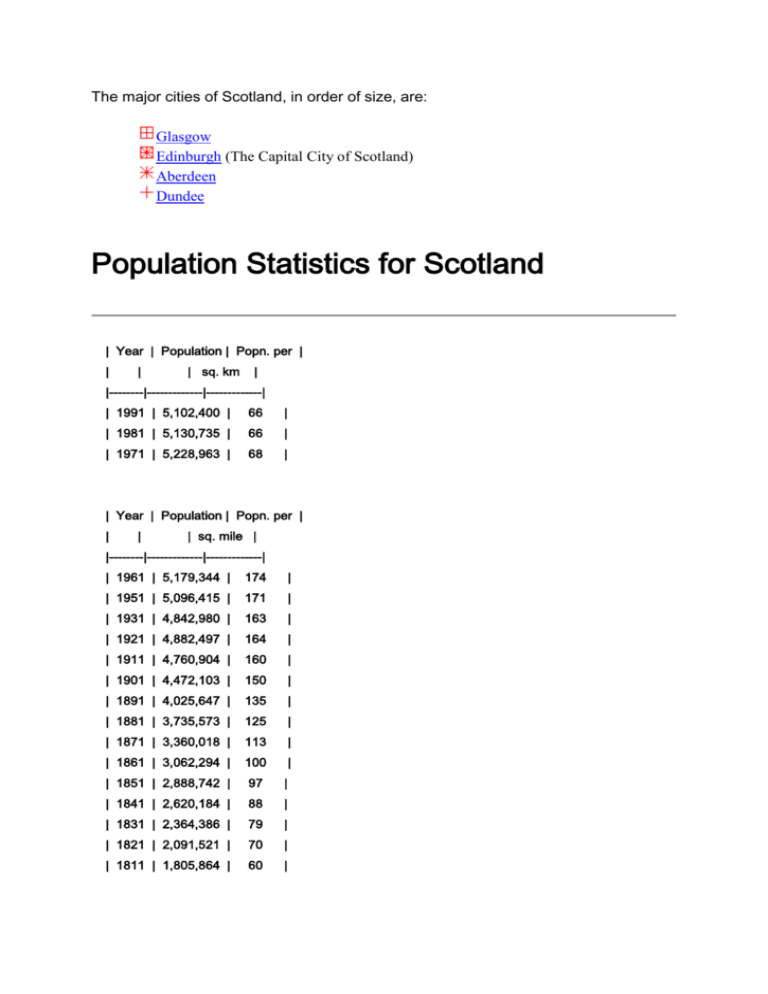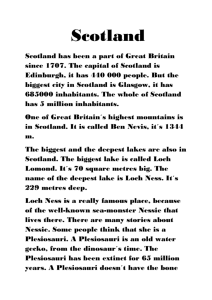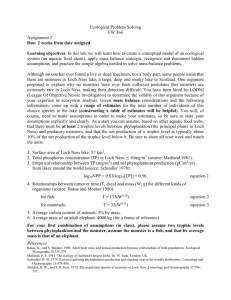The major cities of Scotland, in order of size, are:
advertisement

The major cities of Scotland, in order of size, are: Glasgow Edinburgh (The Capital City of Scotland) Aberdeen Dundee Population Statistics for Scotland | Year | Population | Popn. per | | | | sq. km | |--------|-------------|-------------| | 1991 | 5,102,400 | 66 | | 1981 | 5,130,735 | 66 | | 1971 | 5,228,963 | 68 | | Year | Population | Popn. per | | | | sq. mile | |--------|-------------|-------------| | 1961 | 5,179,344 | 174 | | 1951 | 5,096,415 | 171 | | 1931 | 4,842,980 | 163 | | 1921 | 4,882,497 | 164 | | 1911 | 4,760,904 | 160 | | 1901 | 4,472,103 | 150 | | 1891 | 4,025,647 | 135 | | 1881 | 3,735,573 | 125 | | 1871 | 3,360,018 | 113 | | 1861 | 3,062,294 | 100 | | 1851 | 2,888,742 | 97 | | 1841 | 2,620,184 | 88 | | 1831 | 2,364,386 | 79 | | 1821 | 2,091,521 | 70 | | 1811 | 1,805,864 | 60 | Unitary Authority Fact Sheet - Population and Area (At 1st June, 1995) Authority Population Area (30.6.93) (hectares) Mainland Aberdeen City 218,220 18,216 Aberdeenshire 223,630 631,736 Angus 111,020 Argyll and Bute 218,396 90,550 Clackmannan 702,300 48,660 15,809 Dumbarton and Clydebank 97,790 17,573 Dumfries and Galloway 147,900 Dundee (City of) 153,710 East Ayrshire 5,500 123,820 East Dunbartonshire East Lothian 644,567 127,527 110,220 85,640 17,551 66,558 East Renfrewshire 86,780 16,802 Edinburgh (City of) 441,620 26,001 Falkirk Fife 142,610 351,200 Glasgow (City of) Highland 29,300 134,045 623,850 17,472 206,900 2,611,906 Inverclyde 89,990 16,724 Midlothian 79,910 34,966 Moray North Ayrshire North Lanarkshire 86,250 223,694 139,020 88,755 326,750 47,648 Perthshire and Kinross 130,470 Renfrewshire 176,970 539,479 26,250 Scottish Borders 105,300 472,749 South Ayrshire 113,960 123,021 South Lanarkshire 307,100 177,789 Stirling 81,630 West Lothian TOTAL 224,320 146,730 42,664 5,048,200 7,319,318 Islands Orkney 19,760 102,498 Shetland 22,830 147,097 Western Isles TOTAL 29,410 72,000 TOTAL SCOTLAND 307,005 556,600 5,120,200 7,875,918 Source: Confederation of Scottish Local Authorities (COSLA) FACTSHEET 2 Scotland in Profile Produced by The Scottish Office Information Directorate in June 1994. This information will be fully updated. Scotland is a country of some 30,414 square miles (78,772 square kilometres) including some 609 square miles of fresh water lochs. Its population was estimated at 5,100,000 at June 1991. Scotland forms the northern part of the island of Great Britain and is situated between latitudes 54°38’ and 60°51’N and the longitudes 1°45’ and 6°14’W. It is bounded west and north by the Atlantic Ocean and on the east by the North Sea, while in the south the border with England runs 60 miles roughly along the line of the Cheviot Hills. The name "Scotland" derives from the Scoti, a Celtic tribe who migrated to Scotland from Ireland during the fifth and sixth centuries and who, in time, merged through conquest and intermarriage with the Pictish tribes to form the nucleus of the Scottish nation. Geographic Features Scotland has some 790 islands ranging from large rocks to land several hundred square miles in area. Of these, the largest and best know are the groups of Shetland and Orkney in the north-east; Lewis, Harris, Skye, Mull and Islay in the Hebrides – the string of islands which lies off the west coast of Scotland – and the islands of Bute and Arran in the Firth of Clyde. About 130 of the Scottish islands are inhabited. The comparatively modest dimensions of mainland Scotland are revealed in the fact that the greatest distance from north to south is only 275 miles (440 kilometres) while the maximum width is 154 miles (248 kilometres); the width, in the country’s central belt between the Firths of Clyde and Forth, is only 25 miles (41 kilometres). However, so rugged and indented is the coastline of Scotland that its aggregate length is estimated at 2,300 miles (3,680). Yet few parts of the country are more than 40 miles (64 kilometres) from salt water. By British standards, Scotland is a mountainous country, having the highest peak in the United Kingdom (Ben Nevis 4,406 feet or 1,356 metres) as well as five other mountains of more than 4,000 feet. Such heights are, of course, modest by European standards but the Scottish Mountains have a beauty and colour rarely matched elsewhere. Scotland consists broadly of three main geographic regions. These are the Highlands, the Central Lowlands, and the Southern Uplands. The Highlands in the north, including the Hebridean islands, account for somewhat more than half the total area of Scotland. The Central Lowlands fall roughly between a line from Dumbarton to Stonehaven in the north and another from Girvan to Dunbar in the south. The term "Lowlands" is something of a misnomer, however, for the region includes a number of hill ranges as well as an abundance of beauty spots and rich, undulating farmland. In the Southern Uplands, likewise, magnificent scenery abounds, though as a rule gentler than that in the Highlands. Seven major hill ranges are in the region, but the highest peak – Merrick, in the Galloway Hills – attains a height of only 2,764 feet (815 metres). In this region, too, lies Scotland’s Borderland, rich in story and legend as well as in beauty and fertility of soil. It is the land of Sir Walter Scott, probably Scotland’s greatest novelist and one of the major figures in European literature as a whole. Scotland is an ideal centre for communications with Europe and North America thanks to its geographical situation. It is served by four modern international airports and has regular air services to Western Europe (including Scandinavia) and to North America. Scotland is linked to the rest of Britain by modern road and rail systems and by scheduled air services. The largest heliport in Europe is in Aberdeen. Despite its northern latitudes, the climate in Scotland is remarkably temperate, one of the main reasons being that it lies athwart of the warming Gulf Stream from the South Atlantic. True, its mean air temperature is 2°F (1.25°C) below that of England, while average rainfall is 15 inches higher in any year. On the other hand, there is no month in which average temperatures in Scotland fall below freezing point, while the difference between summer temperatures in the north and south is usually negligible. The average rainfall in Scotland ranges from 22 inches (560mm) to 40 inches (1,015mm) a year. There are marked variations within the country, the west, particularly the West Highlands, tending to have higher rainfall than the east. In comparison with Europe, the capital of Scotland, Edinburgh, has the same average rainfall as Dieppe – namely 27 inches or 685mm, while Inverness has the same figures as Nancy – 28 inches or 710mm; this is not much more than the average rainfall for the main centres of population in Denmark and Sweden. Aberdeen, Dundee and Perth have the same average rainfall as Lille (31 inches or 785mm) and Gothenburg (30 inches or 775mm). The range of temperature in major towns and cities of Scotland is, as a rule, much less than in cities such as Stockholm or Copenhagen for example. Winters in the main towns and cities of Scotland are much less severe than in southern Sweden or Denmark. They are similar to winters in northern France, although Scottish summers are cooler. Gaelic In legal terms, a ‘national language’, Gaelic is nowadays spoken by some 80,000 Scots in addition to English. The Annual Mod (a literary, musical, vocal and artistic competition) lasts for nearly two weeks and attracts an attendance of 15,000. Gaelic’s long literary tradition is exemplified by many writers today – including Sorley MacLean, hailed in some quarters as one of the most significant poets in present-day Europe. Scotland's Rivers Tay (188 Km or 117 miles long) Spey (177 Km or 110 miles) Clyde (170 Km or 106 miles) Tweed (154 Km or 96 miles) Dee (154 Km or 96 miles) Don (132 Km or 82 miles) Forth (106 Km or 66 miles) (The length quoted is until the River Forth meets its headwaters, its full length is 187 Km or 116 miles, and it is tidal for 85 Km or 53 miles) The Loch Ness Monster Loch Ness is located in the North of Scotland and is one of a series of interlinked lochs which run along the Great Glen. The Great Glen is a distinctive incision which runs across the country and represents a large geological fault zone. The interlinking was completed in the 19th century following the completion of the Caledonian Canal. For many years it has been supposed that there is a large dinosaur-like "monster" resident in Loch Ness. The evidence for its existence are a series of sightings of a plesiosaur-like dinosaur throughout the last 100 years. The case has occasionally been supported by indistinct photographic evidence. However, several scientific studies have been conducted, including thorough sonar surveys of the loch, and these have not revealed any presence of such a "monster". Many people believe that the size (21 square miles) and great depth of the loch (almost 800 feet), together with potential underwater caves, gives the monster many places to hide. Regardless of the truth, the suggestion of the Monster's existence makes Loch Ness one of Scotland's top tourist attractions. Much more info on the Loch Ness Monster The Legend of Nessie See also our Media & Film Section Loch Morar, in the West of Scotland, is also said to support a monster, but the evidence for this is even more tenuous! Finally, the image to silence all the sceptics and Nessie nay-sayers. Innovative Loch Ness researcher and local commentator, Mikko Takala, has managed to obtain this clear photograph of Nessie - a plesiosaur - in Loch Ness. The incredible image was captured at 17.14 on 30 July 2005 in this area. The creature was estimated to be about three and a half meters long and was about fifty meters offshore. No photo trickery has been used, although some other sadly envious "researchers" are already making such unfounded and spiteful allegations. Mikko is interested to know your views about this image. Special thanks to Strider for the image enhancement work in the right hand photo. Viking Long Ship Discovered in Loch Ness The Loch Ness Free Press has received this exclusive press release from Professor Svenson and his Loch Ness research project: Press Release: Professor Svenson and Dr. Theo Valdivik announce the discovery of the remains of a Viking long ship at the bottom of Loch Ness. Using their NAVRAD remote bottom probing submarine, the two eminent academics scanned an area of the loch they had carefully selected using their exclusive mathematical formula and a little luck. Professor Svenson, who has previously discovered many new wonders in Loch Ness, said "we are very excited about this find. Initially we thought we had just come across a few rotting old fence posts but it soon became clear that we were looking at the oldest surviving remains of the Viking presence in Scotland." The pair were even more amazed to discover preserved coffee grounds in the timbers. All previous data indicates that the Vikings did not have access to coffee and this find may cause a whole chapter of their history to be re-written as it now appears that they may have sailed as far afield as South America before heading for the ancient cultural capital of Loch Ness, Drumnadrochit. The remains will now be sent to a mineral processing unit at NASA where they will be carbon dated and injected with fleuron, a special substance that glows if the material around it is more than 1000 years old. Professor Svenson denied that his find was simply a cheap PR exercise to try and boost the flagging tourist season or a vain attempt to get a plaque erected with his name on it. "That's quite ridiculous. Eminent researchers like me are only devoted to the science and research of Loch Ness and would never issue statements unless we thought they were true. The fact that this is the holiday or silly season has absolutely nothing to do with anything". The Highlands of Scotland Tourist Board was unavailable for comment at time of going to press. Welcome to The Legend of Nessie, her Official web site on the Internet that brings you facts, pictures and sightings of this most elusive of creatures. If it's information about the Loch Ness Monster you're after then this is the site to visit. With documented evidence, film, first-hand accounts, stories, scientific studies and expeditions you will find that we are one of the most informative Loch Ness Monster sites on the WWW. Browse through at your leisure and enjoy the wonders and mystery of Nessie and Loch Ness.




